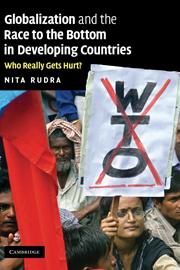Book contents
- Frontmatter
- Contents
- List of figures
- List of tables
- Preface
- 1 Introduction
- 2 The race to the bottom in developing countries
- 3 Who really gets hurt?
- 4 LDC welfare states: convergence? What are the implications?
- 5 Globalization and the protective welfare state: case study of India
- 6 Globalization and the productive welfare state: case study of South Korea
- 7 Globalization and the dual welfare state: case study of Brazil
- 8 Conclusions
- Appendix A LDC social spending
- Appendix B Assessing potential labor power
- Appendix C Additional tests for the RTB hypothesis
- Appendix D Variables in the inequality model
- Appendix E Technical notes on Gini coefficients
- Appendix F LDC Gini coefficient statistics
- Appendix G Robustness check
- Appendix H Conditional impact of trade on inequality
- Appendix I Descriptions and sources of variables
- Appendix J Cluster results minus outcome variables
- Appendix K Dendrogram for cluster analysis
- Appendix L Poverty tables
- Appendix M Social expenditures on social security, health, and education in India (percent of GDP) based on national data
- References
- Index
Preface
Published online by Cambridge University Press: 22 September 2009
- Frontmatter
- Contents
- List of figures
- List of tables
- Preface
- 1 Introduction
- 2 The race to the bottom in developing countries
- 3 Who really gets hurt?
- 4 LDC welfare states: convergence? What are the implications?
- 5 Globalization and the protective welfare state: case study of India
- 6 Globalization and the productive welfare state: case study of South Korea
- 7 Globalization and the dual welfare state: case study of Brazil
- 8 Conclusions
- Appendix A LDC social spending
- Appendix B Assessing potential labor power
- Appendix C Additional tests for the RTB hypothesis
- Appendix D Variables in the inequality model
- Appendix E Technical notes on Gini coefficients
- Appendix F LDC Gini coefficient statistics
- Appendix G Robustness check
- Appendix H Conditional impact of trade on inequality
- Appendix I Descriptions and sources of variables
- Appendix J Cluster results minus outcome variables
- Appendix K Dendrogram for cluster analysis
- Appendix L Poverty tables
- Appendix M Social expenditures on social security, health, and education in India (percent of GDP) based on national data
- References
- Index
Summary
My interest in politics and globalization emerged in my adolescence during frequent visits to India. Time after time I saw that the immense scale of poverty and destitution remained the same. Life at home in the United States, on the other hand, seemingly held the promise of endless choices and opportunities for advancement. I was particularly struck by the stark contrast between the health care and resources available to my grandfather, a village doctor in one of the most remote and poorest “gramas” (villages) in West Bengal, and my father, an FRCS (Fellow of the Royal College of Surgeons) surgeon practicing in Florida. I was astounded that two such diametrically opposed economies coexisted in the same world. From here, eventually, questions of distribution, international economics, politics, government choices, and policy design emerged. In my early years of graduate school I became particularly intrigued by the extent to which domestic policy choices seemed constrained by the global economy, and thus fascinated with issues in international political economy. It took some further study and field experience to begin to grasp the true complexity of the situation.
This book is my attempt to scratch the surface of how and why developing and developed countries face such different challenges in (and responses to) the current era of globalization. It is a product of my struggles with understanding the distributional consequences of globalization, and questions of if and how developing country governments can respond to it.
- Type
- Chapter
- Information
- Globalization and the Race to the Bottom in Developing CountriesWho Really Gets Hurt?, pp. xv - xxPublisher: Cambridge University PressPrint publication year: 2008

